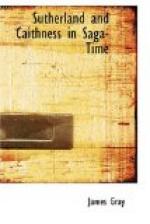What is worthy of notice is that it is clear from the place-names that after the Norse conquest the Norse held and named most of the lower or seaward parts of the valleys and nearly all the coast lands of Cat and Ross as far south as the Beauly Firth, and the Picts occupied and were never dispossessed of the upper parts of the valleys or the hills all through the Norse occupation. In other words, as conquerors coming from the sea, the Norsemen seized and held the better Pictish lands near the coast, which had been cultivated for centuries, and on which crops would ripen with regularity and certainty year after year. But as time went on the Pictish Maormor pressed the Norse Jarl more and more outwards and eastwards in Cat.
We must also remember the enormous power of the Scottish Crown through its right of granting wardships, especially in the case of a female heir. Under such grants the grantee, usually some very powerful noble, took over during minority the title of his ward and all his revenues absolutely, in return for a payment, correspondingly large, to the Crown. If the ward was a female, the grantee disposed of her hand in marriage as well.
After these preliminary notes, we may now again glance at the Scots, who were destined, from small beginnings, by a series of strange turns of fortune and superior state-craft, in time to conquer and dominate all modern Scotland north of the Forth, then known as Alban.
The Scots, as already stated, had come over from Ulster and settled in Cantyre about the end of the fifth century, and for long they had only the small Dalriadic territory of Argyll, and even this they all but lost more than once. At the same time, after 563, they had a most valuable asset in Columba, their soldier missionary prince, and his milites Christi, or soldiers of Christ, who gradually carried their Christianity and Irish culture even up to Orkney itself, with many a school of the Erse or Gaelic tongue, and thus paved the way for the consolidation of the whole of Alban into one political unit by providing its people with a common language.
But in order to live the Scots had been forced to defeat many foes, such as the Britons of Strathclyde, whose capital was at Alcluyd or Dunbarton,[16] the Northumbrians on the south, and the Picts of Atholl, Forfar, Fife and Kincardine, which comprised most of the fertile land south of the Grampians. The great Pictish province of Moray on the north of the Grampians, however, remained unsubdued, and it took the Scots several centuries more to reduce it.
It was when the Scottish conquests above referred to were thus far completed that the new factor, with which we are mainly concerned, was introduced into the problem. This factor was, as stated, the Northmen.
CHAPTER III.
The Early Norse Jarls.




